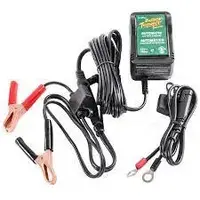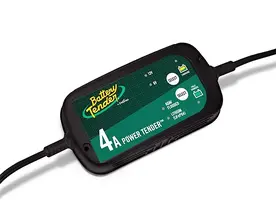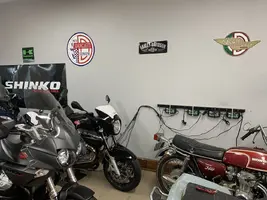- Joined
- Jun 26, 2011
- Messages
- 6,526
- Reaction score
- 8,270
This issue rears its ugly head every so often so I thought I'd write about it.
When you decide to utilize a Battery Tender (or other manufacturer) type charger to maintain your battery, (and I strongly recommend it), please do not waste your time and money on the 750mAmp wall plug in model. It does not have enough beans to do the job on a Moto Guzzi (or other make) motorcycle.
I charge literally hundreds of motorcycles every year in my shop (every motorcycle that comes through the shop door goes onto a charger from day 1) and through extensive trial and error, I have found that the best all around unit size, is a 4A charger. The Battery Tender 4A units in my shop (I have a dozen or more) have always maintained my customers batteries during waiting for repairs and long term winter storage. These particular Battery Tender brand chargers have a 6V switch which I have only used very rarely, but the AGM/Flooded and LiFePO4 settings are fantastic as I have some Lithium battery bikes of my own and customers too.
I also use them exclusively on my personal motorcycles.
The 4A unit can usually (98% of the time) bring back a badly discharged batter, and restore it to full functioning capacity. The 750mA unit will think the battery is fully charged, and shut itself off, when the battery is actually almost discharged.
That 750mA unit just doesn't work at all in my experience or the 2 dozen customers who have brought me dead batteries that were supposedly maintained by that crap unit..
FWIW: Utilizing this exact method of using the 4A charges, my brand new 2012 Stelvio, finally had to have the OEM battery replaced after 10 years! Yes, 10 YEARS! My Ural, has been using the same battery for 5 years now and so have my other 6 motorcycles (batteries in service for many years now). These things work!
JUNK 750mA UNIT:

GREAT 4A UNIT

One bank of four, 4A chargers on the wall of my shop floor. I really love these things!

When you decide to utilize a Battery Tender (or other manufacturer) type charger to maintain your battery, (and I strongly recommend it), please do not waste your time and money on the 750mAmp wall plug in model. It does not have enough beans to do the job on a Moto Guzzi (or other make) motorcycle.
I charge literally hundreds of motorcycles every year in my shop (every motorcycle that comes through the shop door goes onto a charger from day 1) and through extensive trial and error, I have found that the best all around unit size, is a 4A charger. The Battery Tender 4A units in my shop (I have a dozen or more) have always maintained my customers batteries during waiting for repairs and long term winter storage. These particular Battery Tender brand chargers have a 6V switch which I have only used very rarely, but the AGM/Flooded and LiFePO4 settings are fantastic as I have some Lithium battery bikes of my own and customers too.
I also use them exclusively on my personal motorcycles.
The 4A unit can usually (98% of the time) bring back a badly discharged batter, and restore it to full functioning capacity. The 750mA unit will think the battery is fully charged, and shut itself off, when the battery is actually almost discharged.
That 750mA unit just doesn't work at all in my experience or the 2 dozen customers who have brought me dead batteries that were supposedly maintained by that crap unit..
FWIW: Utilizing this exact method of using the 4A charges, my brand new 2012 Stelvio, finally had to have the OEM battery replaced after 10 years! Yes, 10 YEARS! My Ural, has been using the same battery for 5 years now and so have my other 6 motorcycles (batteries in service for many years now). These things work!
JUNK 750mA UNIT:

GREAT 4A UNIT

One bank of four, 4A chargers on the wall of my shop floor. I really love these things!

Last edited:



